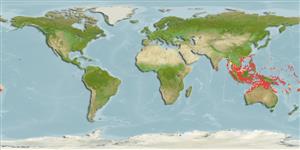Environment: milieu / climate zone / depth range / distribution range
Ecologia
marinhas; estuarina associadas(os) a recifes; intervalo de profundidade 5 - 80 m (Ref. 37816). Tropical; 25°N - 21°S
Indo-West Pacific: Thailand to Vanuatu, north to the Ryukyu Islands (Ref. 559) and southeast China, south to Australia.
Tamanho / Peso / Idade
Maturity: Lm ? range ? - ? cm
Max length : 25.0 cm TL macho/indeterminado; (Ref. 48635)
Espinhos dorsais (total) : 15 - 17; Raios dorsais moles (total) : 7 - 9; Espinhos anais: 2; Raios anais moles: 10 - 12. Body colors highly variable and best identified by the patterns on the fins (Ref. 48635). Lower 2 pectoral rays are entirely free and used as "walking" legs and the inner face of the fin is brightly colored (Ref. 37816).
Found on open sandy or silty substrates of lagoon and seaward reefs. Often buries itself and easily overlooked. Uses pectoral fins to startle predators and shows color during courtship (Ref. 48635). Feeds on small fishes and crustaceans (Ref. 9710). The venom of this fish can be deadly to man. Its ability to camouflage itself by living half-buried presents a real danger. Solitary on sand and mud bottoms (Ref 90102).
Life cycle and mating behavior
Maturities | Reprodução | Spawnings | Egg(s) | Fecundities | Larvas
Myers, R.F., 1991. Micronesian reef fishes. Second Ed. Coral Graphics, Barrigada, Guam. 298 p. (Ref. 1602)
Categoria na Lista Vermelha da IUCN (Ref. 130435)
Utilização humana
Pescarias: espécies comerciais; Aquário: Espécies comerciais
Ferramentas
Relatórios especiais
Descarregue XML
Fontes da internet
Estimates based on models
Preferred temperature (Ref.
123201): 26.3 - 29, mean 28.2 °C (based on 1088 cells).
Phylogenetic diversity index (Ref.
82804): PD
50 = 0.5010 [Uniqueness, from 0.5 = low to 2.0 = high].
Bayesian length-weight: a=0.01862 (0.01022 - 0.03394), b=2.89 (2.73 - 3.05), in cm total length, based on LWR estimates for this species & (Sub)family-body (Ref.
93245).
Nível Trófico (Ref.
69278): 4.0 ±0.66 se; based on food items.
Resiliência (Ref.
120179): Médio, tempo mínimo de duplicação da população 1,4 - 4,4 anos (Preliminary K or Fecundity.).
Fishing Vulnerability (Ref.
59153): Low vulnerability (15 of 100).
Nutrients (Ref.
124155): Calcium = 55.4 [23.3, 140.2] mg/100g; Iron = 0.564 [0.265, 1.169] mg/100g; Protein = 18 [16, 20] %; Omega3 = 0.197 [0.081, 0.589] g/100g; Selenium = 31.7 [15.2, 76.9] μg/100g; VitaminA = 81.8 [20.5, 340.5] μg/100g; Zinc = 1.22 [0.79, 1.85] mg/100g (wet weight);
